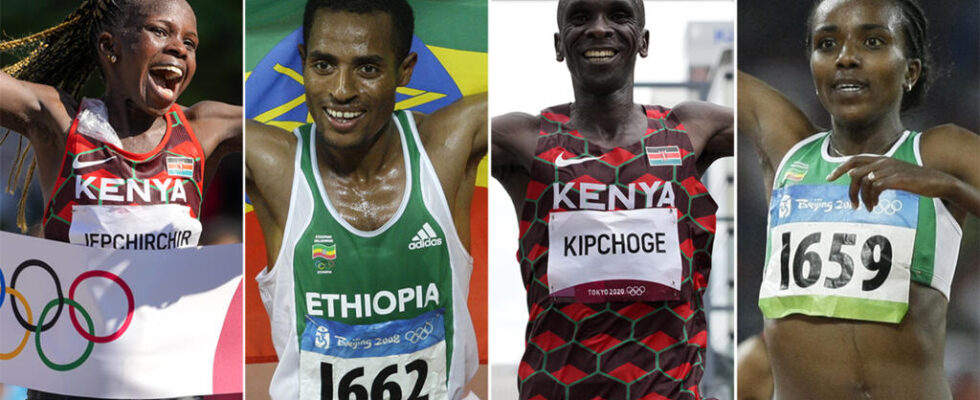If the sprint is dominated by the United States and Jamaica, the long-distance races are under the control of two nations from the Horn of Africa. Ethiopia and Kenya monopolize the podiums at the Olympic Games in these athletics disciplines. An omnipotence that owes nothing to chance.
6 mins
Say that the Olympic history ofEthiopia and Kenya is closely linked to long-distance running to put it mildly. The numbers are sufficient in themselves. In fourteen appearances at the Summer Games, Ethiopia has won 58 medals, all in athletics: in detail, 56 were won in long-distance races, and two in middle-distance races. Kenya has won 113 medals in fifteen editions of the Olympic Games : 106 were gleaned in athletics, including 69 in long-distance races and 28 in middle-distance races.
No wonder, then, that these two countries are considered the kingdoms of long-distance running. In Kenya, we even speak of the “Mecca of the marathon”, the flagship discipline of endurance races. Whether at the Olympic Games, the Worlds, during the main competitions or even in the record books, Ethiopia and Kenya outrageously dominate over 5,000 meters, 10,000 m and marathon, as well as over 3,000 m steeplechase (race of obstacles run in the background). Behind them, Uganda, Somalia and Eritrea also managed to do well, proving the mastery of the countries of the Horn of Africa.
The altitude “ gives wings » to Kenyan and Ethiopian athletes
The hegemony of Ethiopia and Kenya has been the subject of numerous investigations, with always the same crucial question: why are the athletes of these countries so strong? A track leads to the altitude of the regions where their best cross-country skiers come from. In 2015, our colleagues from France 24 went to Iten, Kenya. This town, located in Elgeyo-Marakwet County, is a factory for underground specialists. Eliud Kipchogedouble Olympic marathon champion, former official world record holder and unofficial world record holder (1’59’40 in 2019, in special conditions), notably passed through this place dedicated to performance in marathon races. background and nicknamed “the land of champions”.
One of the particularities of Iten is its altitude of 2,600 meters above sea level. A height which “ gives wings to athletes » and made Iten « an extraordinary training place where every stride pays off twice », indicates France 24, which continues: “ On average, athletes’ long-distance times are five seconds per kilometer worse here. Reported over 40 kilometers, that’s almost four minutes saved when they go back down to sea level. »
Henry Rono, former world record holder over 3,000 m steeplechase, 5,000 m and 10,000 m in the 1970s and 1980s, detailed how this altitude forges champions: “ There is much less oxygen in the air here. So when you train at high altitude and then come back down, your body is more able to use the oxygen in the air, grab it and use it more quickly. People who train in Iten therefore have a huge advantage when they come back down to participate in races, in Europe for example. They get less tired, they can manage their competitions better. »
This is why many athletes from Europe and America come to train in Kenya or Ethiopia. They come to find the difficulty to which the Kenyan and Ethiopian champions are subjected on a daily basis, in the hope of getting closer to their times. A laudable approach, but still ineffective so far at the Olympics, where the podiums in long-distance races have been almost confiscated for several years by athletes from the Horn of Africa or by naturalized athletes like Mohamed Farah (British of origin Somali), Sifan Hassan (Dutch of Ethiopian origin) or Paul Chelimo (American of Kenyan origin).
Running from a young age
However, the explanation designating altitude as the main asset is subject to caution. As demonstrated Slate in a 2018 article, some studies dispute a performance-boosting effect for Kenyans and Ethiopians accustomed to altitude and competing at sea level. Other runners from countries and areas at altitude, elsewhere in the world, do not fail to challenge this domination.
The results from Ethiopia and Kenya have been the subject of much research, and so far none has been able to establish with certainty the reason(s) which explain such pre-eminence. Some highlight physical characteristics adapted to the background, depending on ethnic groups or origins. Others simply advance the culture of these countries.
In Ethiopia and Kenya, people walk and run a lot from childhood, a fortiori in poor areas where cars are not numerous. As a child, the Ethiopian Haile Gebrselassie, Olympic champion over 10,000 m in Atlanta in 1996 and in Sydney in 2000, covered 10 kilometers each way between the family farm and school. From that time, he kept this running posture with his left arm folded, as when he ran while holding his school books. Gebrselassie’s story also illustrates a simple reality: like football in Brazil and Argentina, sprinting in Jamaica or rugby in New Zealand, long-distance running is inscribed in the Kenyan DNA and culture and Ethiopian.
What should we expect from these two nations in Paris? Obviously, they are favorites for a new harvest of medals in the 5,000 m, 10,000 m and the marathon. Kenya must, however, erase the affront of Tokyo 2020 over 3,000 m, where the Moroccan Soufiane el-Bakkali took gold, putting an end to nine Kenyan victories in a row between the 1984 Olympics and those of 2016. And in the streets of Paris, everyone will have a thought, during the marathon, for Kelvin Kiptum. In October 2023, the athlete, although unaccustomed to running this distance, broke the world record and became the first man to go under 2 hours and 1 minute (2’0’35). But Road accident claims life of 24-year-old Kenyan prodigy, as well as his trainer, last February. His memory will be honored during the 2024 Olympics in which he should have taken part.
